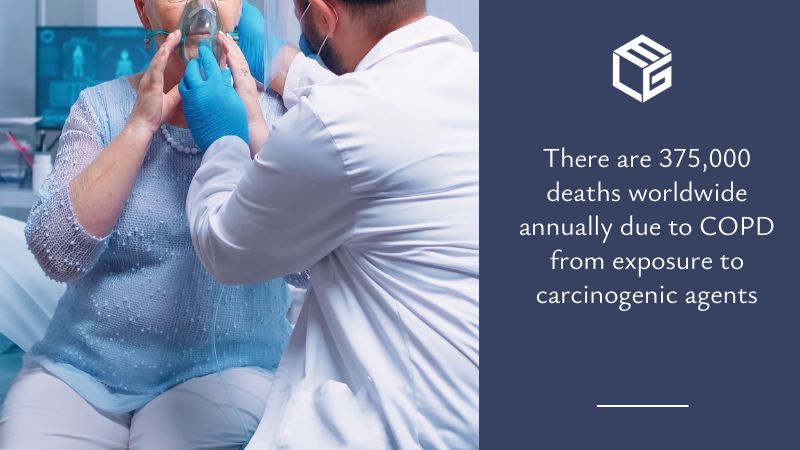COPD from exposure to carcinogenic agents in the workplace results in 375,000 deaths worldwide annually
There are multiple studies supporting the high incidence of COPD among individuals who were exposed to airborne toxic agents on the job, including asbestos.
A study conducted on 316,729 construction workers revealed a two-and-a-half higher mortality rate from COPD in people who had been exposed to hazardous agents than in those with no history of toxic exposure.
Similar to other diseases stemming from asbestos exposure, COPD will typically occur within several decades from the first contact with asbestos. The symptoms become increasingly severe over time and if the sufferer was heavily exposed to asbestos, there is a considerable risk of COPD later developing into a form of cancer, as asbestos fibers are more likely to cause tissue damage when the lungs are already weakened.
Common signs and symptoms of COPD and asbestos exposure:
- wheezing
- difficulty breathing
- swollen feet, ankles, or legs
- tightness in the chest
- unintentional weight loss
- shortness of breath during physical activities
- a productive cough
- low muscle endurance
- frequent respiratory infections
Today, approximately 15 million Americans suffer from chronic obstructive pulmonary disease, while 12 million others remain undiagnosed. The condition is currently the fourth cause of death throughout the country. There are two types of chronic obstructive pulmonary disease: emphysema and chronic bronchitis. The former entails the weakening of the air sacs of the lungs (alveoli), whereas the latter involves the inflammation and narrowing of the bronchial tubes, which results in a persistent cough and increased mucus production. Both types of COPD decrease breathing capacity to a great extent. A series of factors can lead to the deterioration of the alveoli and the bronchial tubes, such as smoking, the rare genetic disorder known as alpha-1-antitrypsin deficiency, the inhalation of fumes released by burning fuel, as well as occupational asbestos exposure.
Our lungs are unable to expel asbestos fibers. Thereby, once they reach the inside of the organs, asbestos fibers will embed themselves in tissue, gradually irritating the area in question.
Within 10 to 50 years, the damage inflicted by asbestos to the lungs may result in COPD, which often implies a combination of emphysema and chronic bronchitis. It is worthy of note that suffering from COPD as a consequence of workplace asbestos exposure makes you substantially more prone to developing malignant diseases such as lung cancer or pleural mesothelioma over the years.
The first symptom of COPD is usually a lingering, productive cough. In severe cases, blood can be found in the sputum expelled by the person who suffers from this condition. Shortness of breath is also common in the early phases of COPD.
Because COPD is insidious and symptoms are rarely experienced by people until it reaches advanced phases, we strongly advise individuals with a history of asbestos exposure – particularly smokers – to undergo a biannual medical examination, which will help prevent late detection in the unfortunate event the condition has developed.

